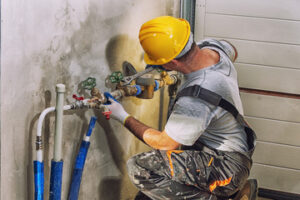Industry sectors that use diesel engines, from transportation to agriculture, rely heavily on diesel mechanics for their optimal functionality and compliance with regulatory requirements. This market segment drives consistent demand for repair services.

Rebuilding a diesel engine enhances performance and extends the lifespan of machinery. It can also be a cost-effective alternative to replacement, as long as the right tools and attention to detail are used. Whether the rebuild is for commercial vehicles, industrial equipment, or consumer goods, the process can be challenging and time-consuming. Nonetheless, it is essential for improving operational efficiency and reducing maintenance costs. Visit https://www.dieselprokansascity.com to learn more.
The diesel repair service market can be segmented by vehicle type, with four prominent sub-segments: trucks, buses, construction equipment, and agricultural equipment. Trucks represent a significant share of the market, as they are key to freight and logistics operations. Buses, which are widely used in public transportation, also require diesel repair services to ensure operational efficiency and minimize downtime. Construction equipment, such as excavators and bulldozers, is heavily reliant on diesel engines for operation. Its frequent use under challenging environmental conditions makes specialized diesel repair services vital for ensuring productivity and minimizing downtime.
A complete diesel engine rebuild involves the disassembly and inspection of its components, followed by the replacement of damaged parts with high-quality replacements. This includes the replacement of gaskets, seals, bearings, O rings, and oil pumps. It may also include the reworking of critical components, such as pistons and crankshafts. After the rebuild is complete, the engine undergoes testing to ensure that it operates correctly. This includes adjusting timing and fuel injection settings, as well as running the engine through performance tests to ensure compliance with all applicable regulations.
In addition to enhancing the performance of diesel engines, regular maintenance helps reduce their emissions and save money on fuel costs. Routine checks can help prevent problems, such as engine overheating and poor fuel economy. Diesel mechanics are skilled at detecting these issues and recommending appropriate repairs to keep engines in top condition.
A good diesel engine can last for years, but even a seemingly healthy one can wear down over time. A few signs of engine wear include leaking oil, reduced power output, and misfiring. When these issues are ignored, they can lead to costly repairs or an entire engine replacement.
Repair
If your diesel car is not starting or isn’t running as well as it used to, it could be caused by a lack of compression. In this case, you’ll need to replace the piston rings. However, before you do this, make sure to check the condition of the cylinder liner. If there’s a slight ovality or it is worn out, you may need to bore it to ensure that the new piston rings will fit correctly.
Changing the filter on a regular basis and keeping water out of the fuel system are essential for your diesel engine to function properly. A clogged filter leads to insufficient lubrication, which can cause damage to the engine. In addition, it is important to maintain the proper fuel pressure and temperature of your diesel engine.
You should always seek a professional to perform any repair job that is more serious than routine maintenance. Diesel mechanics specialize in inspecting, repairing, and rebuilding diesel engines for vehicles like trucks and buses. These mechanics run diagnostic tests and find the source of problems to prevent them from recurring. They also clean the air and oil filters, check the coolant levels, and replace faulty parts.
Diesel engines generate a lot of heat, so it’s important to keep the cooling system working properly. This includes the radiator, water pump, and thermostat. To avoid overheating, it’s important to keep the coolant at a high level and keep the hoses and radiator clean.
The diesel repair service market is divided into several segments, based on end-users, vehicle types, and geographical regions. The trucking segment accounts for the largest share of this market, as these vehicles are vital to freight and logistics operations. Other segments include busses, construction equipment, and agricultural machinery.
Individual diesel owners are another crucial sub-segment of this market, as they seek repair services to keep their personal vehicles safe and efficient. These customers prioritize cost-effectiveness and convenience, driving demand for repair shops that cater to these needs. Lastly, the government and public sector segment represents municipal fleets and public transportation systems that rely on diesel technologies. This segment demands reliable, fast-acting diesel repair services that meet strict emission regulations.
Maintenance
A diesel engine is a powerful and efficient vehicle power source. However, it requires regular maintenance to keep it working at its best. There are many maintenance services that can be performed, including replacing the fuel filter, draining the coolant, and checking the power steering fluid. In addition, a diesel vehicle should be kept well-lubricated to ensure proper functioning. Keeping these fluids at the proper levels can also prevent overheating.
The diesel repair service market is a vital segment that addresses the maintenance needs of diesel engines and vehicles. This sector is fueled by the growing fleet of diesel vehicles and heavy machinery, strict emission regulations, and growing demand for energy-efficient solutions. Additionally, the aging of diesel vehicles contributes to a higher demand for repair services.
Diesel technicians work on a wide range of diesel-powered vehicles and equipment, such as trucks, buses, and large industrial machinery. These mechanics are responsible for inspecting, diagnosing, and repairing these large vehicles. They are also tasked with keeping track of fleet maintenance and ensuring compliance with regulatory standards.
The first step in maintaining a diesel engine is to change the fuel filters. These filters are located between the fuel tank and the engine to keep out dirt, debris, and water. These filters should be replaced every 16,000 to 24,000 km. Changing the fuel filters can improve fuel economy and performance.
Other routine maintenance tasks that should be performed include draining the radiator and flushing the cooling system. This will remove the acidic water that can erode the radiator and cause overheating. The oil in the diesel engine should be changed at least once a year. Lastly, it is important to check the air pressure in the tires, as this can affect engine performance.
The cylinder block is the main structure of a diesel engine, and it houses the cylinders, pistons, and crankshaft. It is made from cast iron or aluminum alloy and must be able to withstand the extreme pressure and temperature generated by combustion. The cylinder block should be checked for cracks and wear, and it should be inspected regularly to ensure that all the moving parts are properly lubricated. This can prevent excessive wear and damage to the other components of the diesel engine.
Replacement
If your diesel engine is showing signs of trouble like sputtering at high speeds, surging or failing to start, you may be facing issues with fuel delivery. The problem may be as simple as a clogged fuel filter or a more serious one such as a defective fuel pump or faulty injectors. Fuel delivery is vital to the performance of your diesel engine and addressing problems with it promptly will save you money in the long run by preventing fuel injection system failure.
Another sign that your diesel engine is in need of repair is excessive blow-by, or excess oil being blown past the piston rings and into the crankcase. This can cause overheating and oil consumption. It is best to get a professional to take a look at the engine to find the source of the issue.
A clogged radiator can restrict coolant flow, which can lead to high temperatures and potentially catastrophic damage to your engine. It is important to flush and replace the coolant at manufacturer-recommended intervals to avoid mineral buildup and ensure proper flow. You should also inspect the water pump and thermostat for leaks or issues that may result in erratic engine temperatures.
Diesel engines are renowned for their durability and robust machinery, but they do require regular maintenance and repair to unleash their full potential. Unlike gasoline engines, diesels use compression ignition rather than spark plugs to ignite the air and fuel mixture. The high compression ratios and forces in diesel engines create a more intense environment that results in accelerated wear and tear on components.
Diesel-powered vehicles and equipment are critical for diverse industries, including transportation, construction, agriculture, and energy production. They also rely on specialized components to meet strict emission standards. This creates a need for reliable diesel repair services that provide expert diagnosis and timely repairs to minimize operational disruptions. The market for diesel repair services is segmented on the basis of service type, vehicle type, and end-user. Routine maintenance is the largest segment, comprising of tasks such as routine oil changes and filter replacements. The second segment is repair, which includes diagnostic and remedial work that restores a diesel engine’s functionality after an issue or malfunction.



